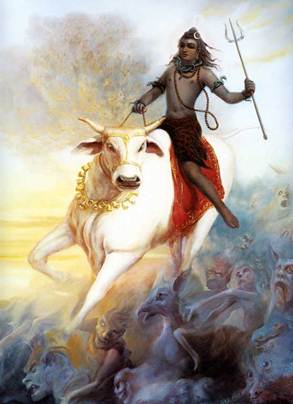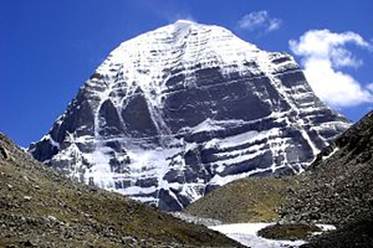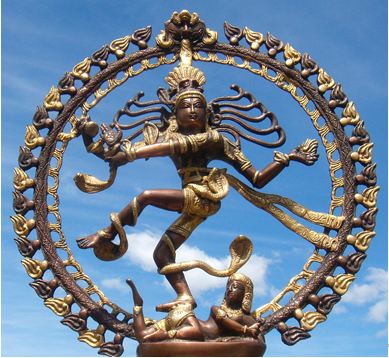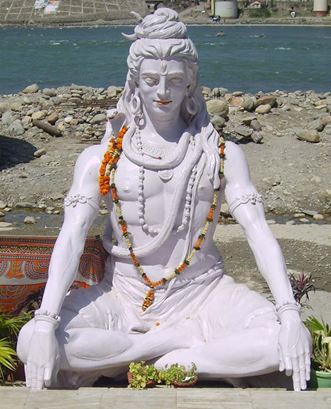|
Shiva is one of the most well-known gods of India. Together with Brahma and Vishnu, he is a part of the Hindu Trinity –Trimurti. Shiva, Brahma, and Vishnu are considered three manifestations of the One Higher Being. They are “three in one,” corresponding to the undivided essence of the western Trinity: the Father, the Son, and the Holy Spirit.
Brahma personifies aspects of God the creator; Vishnu - the keeper and the defender; and Shiva - the destroyer and the annihilator.
Shiva embodies all of these aspects for Hindus who choose him as their Supreme God. Shiva’s followers worship him as higher Reality, the absolute origin of God. They see in him the Guru of all gurus, the destroyer of worldliness, ignorance, evil and villains, hatred and diseases. He bestows wisdom and longevity, embodies self-renunciation and compassion.
 The name “Shiva” originates from the Sanskrit word meaning “good,” “kind,” and “friendly.” The diversity of Shiva’s aspects is represented in many of his names. Thus, the Hindu sacred text called “Shiva Purana,” cites 1008 different names of Shiva. One of them is Shambhu, which means “gracious” or “bringing happiness.” Another name, Shankara, means “giving joy” or “beneficial.” As Mahadev, he is a “great god.” Ishvara (Master) is the name of Shiva that means that he possesses all glory inherent to the Divine. The name “Shiva” originates from the Sanskrit word meaning “good,” “kind,” and “friendly.” The diversity of Shiva’s aspects is represented in many of his names. Thus, the Hindu sacred text called “Shiva Purana,” cites 1008 different names of Shiva. One of them is Shambhu, which means “gracious” or “bringing happiness.” Another name, Shankara, means “giving joy” or “beneficial.” As Mahadev, he is a “great god.” Ishvara (Master) is the name of Shiva that means that he possesses all glory inherent to the Divine.
Pashupati is another name which means “master of the cattle.” As Master of the cattle, Shiva is a shepherd or a pastor of the souls. Shiva is depicted riding a white bull, whose name is Nandi, meaning “joyful.” According to a Hindu tradition, Nandi was a human, one of the followers of Shiva who took the form of a bull because his human body wasn’t strong enough to contain his religious ecstasy occurring in the presence of Shiva.
 The mountain Kailash is Shiva’s throne and also the location of his paradise country. This majestic mountain is the highest peak of the Kailash Range in the Tibetan Himalayas The mountain Kailash is Shiva’s throne and also the location of his paradise country. This majestic mountain is the highest peak of the Kailash Range in the Tibetan Himalayas
Hindus worship Kailash as the most sacred mountain in the world and they make pilgrimages there.
Shiva is full of contrasts. He symbolizes both contemplation and action. He is often portrayed as a beggar yogi immersed in deep meditation.
Legends say that Shiva walks around the earth with a bowl for handouts. He teaches that renunciation, rejection of attachments, indifference to success and failure - all of these are ways to Him.
Shiva is known also as Mrityunjaya - the One who conquers death. He is also Kamare, the Destroyer of desires. These two names demonstrate that he, who destroys desires, can defeat death, because desires give birth to actions, actions give birth to consequences, consequences give birth to dependence and lack of freedom, which result in the new birth leading to death.
As Maha Yoga, or great yoga, Shiva is the King of all yogis, the higher embodiment of spirit of asceticism. Shiva also personifies the moving Universe. In the Hindu sacred text “Kurma Purana”, Shiva says: “Such am I, the Divine Sovereign. Moved by the Highest Bliss, I, the Yogi, eternally dance the Cosmic Dance.”
According to Hindu beliefs, Shiva executes an array of various dances. One of them is called Tandava. It is a dance of creation and destruction. While dancing, Shiva leads the Universe into emergence, supports it, and then while dancing, takes it away from its emergence at the end of an era. Shiva is an embodiment of Ananda (the highest pleasure), and from there He originates the dance Tandava, which He enjoys, using all Space as a stage.
 The most famous image of Shiva is the image of Nataraja, the King of Dancers, or the Lord of Dance. Nataraja dances in a golden palace in the center of the Universe. This golden palace represents the human heart. One of the Hindu hymns glorifying Shiva’s dance says: “dancing, he appears in an immaculate lotus of the heart.” The most famous image of Shiva is the image of Nataraja, the King of Dancers, or the Lord of Dance. Nataraja dances in a golden palace in the center of the Universe. This golden palace represents the human heart. One of the Hindu hymns glorifying Shiva’s dance says: “dancing, he appears in an immaculate lotus of the heart.”
Relations between Shiva and his followers bear a very personal character. Despite the fact that he lives on the mount Kailas, his favorite dwelling place is in the hearts of the devoted.
For Hindus, the Ganges River represents a refreshing river of spiritual wisdom. According to a Hindu tradition, when gods decided to let the Ganges River descend from Heaven, Shiva was in the center of a whirlpool of light - the energy rotating around the rushing river, which was a river of light. When it became a terrestrial river, Shiva was the balancing factor between heaven and earth because he took the blow of the huge weight of the falling water onto his own head, so that this huge flow wouldn’t split the Earth. As the river flowed through Shiva’s tangled hair, the waterfall was deprived of its force. It split into seven sacred rivers, and the waters softly descended onto earth. Therefore, Hindus consider the water in the Ganges River to be sacred, magical, and clearing for everything. The Ascended Masters are teaching that these seven sacred rivers also represent seven beams of white light coming from the Holy Spirit.
The role of Shiva corresponds to the role of the Holy Spirit in the western Trinity.
In the ancient text it is told: “Understand the value of an image which Shiva has accepted for people to honor Him. In His throat, he has the holocaust-producing poison, Halhala, that can destroy all life in a trice. On His head there is the sacred river, the Ganges, waters of which can heal all diseases anywhere and everywhere (the current of the Ganges River symbolizes the nectar of immortality). On His forehead there is a fiery eye (an eye of wisdom). There is a cool and soothing Moon on His head (the crescent indicates that He controls His mind completely). On His wrists, ankles, shoulders, and neck He wears deadly cobra, which live in the life-giving breath of air (prana).” Most people are afraid of only the sight of snakes, but Shiva decorates His body with them. This means that Lord Shiva is absolutely free from fear and is immortal. Snakes, as a rule, live hundreds of years. The snakes swirling on Shiva’s body symbolize to us that He is Eternal.
Shiva is an example of great patience and endurance. He holds poison in his throat, that according to legend, he drank so that the poison wouldn’t have poisoned all life on earth. On his head He carries the blessed Moon, which everyone meets with joy. It is necessary for a human to learn a lesson from this: he should not spew out bad qualities and tendencies on others, rather, all that he possesses that is useful and kind, he should use for the good of others.
 There are three strips of bhasma or vibhuti on Shiva’s forehead.[2] The meaning of this silent reminder is that it is necessary for a human to destroy three impurities: anava (egoism), karma (action expecting a result), and maya (illusion), and also three vasana (subtle impressions): There are three strips of bhasma or vibhuti on Shiva’s forehead.[2] The meaning of this silent reminder is that it is necessary for a human to destroy three impurities: anava (egoism), karma (action expecting a result), and maya (illusion), and also three vasana (subtle impressions):
– wordly ("Loka Vasana") - desire of friends, family, power, wealth, glory, honor, respect.
– holy scriptures ("Sastra Vasana") - spiritual arrogance, thoughtless accumulation of knowledge, philosophizing.
– corporal ("Deha Vasana") - desire to have a perfect physique, health, a beautiful face, desire to prolong life with consumption of medications.
After having destroyed these impurities and with a pure heart, it is possible to come close to Lord Shiva.
Shiva is also symbolically portrayed in the shape of lingam - the symbol that in most cases constitutes a vertically placed cylinder with a rounded or hemispherical top. The word “lingam” originates from the Sanskrit root “’Li,” which means “merging” or “dissolution.” It is the form in which all other forms are dissolved. Shiva is the God who blesses all beings with the most desired gift of merging with the Absolute.
Shiva is the keeper of everything that is necessary for prosperity. He awards with the treasure of wisdom. Shiva abides in each thought, word, and action because He is standing behind energy, power, and intellect - they are all Him. God manifesting as time, space, and causality is inside us.
The exclamation “Shivoham” (I am Shiva) was proclaimed by those souls that learned the truth in a flash of enlightenment after long years of mind purification and selfless devotion. “Shivoham” means “I am Divine.”
Shiva’s devotees think that “the Name of Lord Shiva chanted in any way, correctly or incorrectly, knowingly or unknowingly, carefully or carelessly, is sure to give the desired result. The glory of the Name of Lord Shiva cannot be established through reasoning and intellect. It can certainly be experienced or realized only through devotion, faith and constant repetition of the Name and singing His hymns with Bhava.”
in his well-known work “Lord Shiva and His Worship,” Sri Swami Sivananda (1887 - 1963), a famous Hindu teacher of the 20th century, speaks about the influence of constant repetition of Shiva’s names and the hymns devoted to Him:
“The mind is purified by constant repetition of Siva-Stotra[3] and Names of Lord Shiva. The Stotras are filled with good and pure thoughts. Repetition of the hymns to Shiva strengthens the good Samskaras. “As a man thinks, that he becomes”. This is the psychological law. The mind of a man who trains himself in thinking good, holy thoughts, develops a tendency to think of good thoughts. His character is molded and transformed by continued good thought. When the mind thinks of the image of the Lord during singing His hymns, the mental substance actually assumes the form of the image of the Lord. The impression of the object thought of is left in the mind. This is called Samskara. When the act is repeated very often, the Samskaras gain strength by repetition, and a tendency or habit is formed in the mind. He who entertains thoughts of Divinity, becomes transformed actually into the Divinity himself by constant thinking. His Bhava or disposition is purified and divinized. When one sings the hymns of Lord Shiva, he is in tune with the Lord. The individual mind melts in the cosmic mind. He who sings the hymns becomes one with Lord Siva.
Just as fire has the natural property of burning inflammable things, so also the Name of Lord Shiva has the power of burning the sins, Samskaras and Vasanas and bestowing eternal bliss and everlasting peace on those who repeat the Name of the Lord.”
References:
1. Mark L. Prophet and Elizabeth Clare Prophet. The Masters and Their Retreats. - m: Moscow, 2006.
2. Sri Svami Sivananda. Lord Shiva and His Worship. Library of the Vedic literature. Penza: the Golden section, 1999.
|